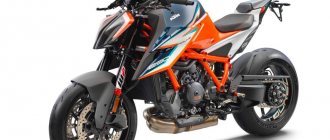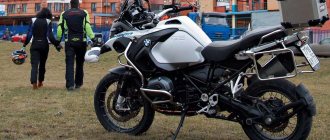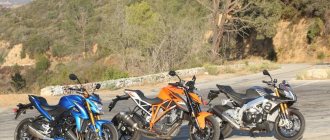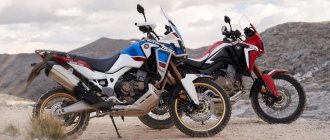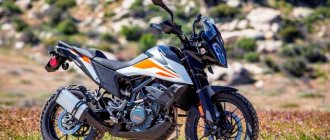KTM 1290 Super Adventure
2015, 1301 cm3, 160 l. s., 229 kg (curb weight without fuel), 265 km/h, RUB 1,349,900.
text: Vladimir Zdorov photo: Alexey Akulshin, Stepan Berestov
In the photo: Vladimir Zdorov
>>It seems that the guys from Mattighofen were not only happy with the fact that they created a sportbike in the guise of a touring enduro – the KTM 1190 Adventure, which significantly undermined the hegemony of the frankly overfed “goose”.
So that marketers from Bavaria do not get bored and have something to do on long winter evenings, the Austrians noticeably “pumped up” their flagship in the world of “tourists”, and the result was the KTM 1290 Super Adventure - one of the most powerful and “evil” touring enduros available today, perfectly suited for ultra-long voyages to anywhere in the world.
Ducati Multistrada and BMW S1000XR? No, these are, of course, very powerful motorcycles, but “pure” crossovers. Then BMW R1200GS Adventure? Sorry, the “German” has 35 liters. With. less... In 2015, none of the motorcycle manufacturers have anything even close to the ultimate machine for conquering space and distances created by the Austrians.
Just think about it: the large touring enduro from KTM has a 160-horsepower engine - this is a figure that is only slightly short of modern liter sportbikes, and the torque of the “Austrian” of 140 Nm is “more fat” than that of many “athletes”!
Bravo to the guys from Mattighofen - they did not start the usual song of supporters of universal tolerance and same-sex marriage: no reduction in power, “straightening” of torque and other vegetable mixture steamed with kosher bread and milk of sacred lamas!
This entire adrenaline plant is tightly surrounded by all-seeing and all-consuming electronics, and it seems to me that all the fictions of science fiction writers about the confrontation between machines and humanity in the future have long ago turned into reality.
They think for us where and how hard to brake, what the efficiency of engine braking should be: the gas handle on all modern “monsters” has long been deprived of a direct, mechanical connection with the throttle - now it is a wire with which you simply send an impulse to the ECU, and then the computer will decide for you what and how exactly you wanted.
The next step will be to give up wires, then the electronics will draw us optimal and safe routes and ultimately simply remove us from control, because humans, unlike machines, tend to make mistakes... Does it look too fantastic? But the future is already here—you just need to look closely.
As I understand it, there are either not many KTMs, or their owners are not known for their verbosity, but, be that as it may, the cat is full of information on them on the website. To the best of my modest strength, I try to slightly correct this annoying fact (in the format of almost a diary of someone who bought the first KTM in my life). At the same time, I’ll just compare the unit a little with my last former ones, including the BMW R1200GS 2014 and the BMW S1000XR 2015. There are almost no photos, I’m not a photographer and in general I rarely take photos, excuse me, gentlemen.
Introduction: “Why KTM”
The answer, in principle, is quite simple: the BMW S1000XR is all good, both in terms of engine and handling, but (1) it consumes gasoline very quickly, much faster than you want to stop and (2) due to the characteristics of the engine and its inherent vibrations, and, most importantly, a very short sixth gear and a very stiff (there is no alternative to rigid) suspension - for my taste it is not entirely comfortable for long trips on fast highways. And finally, even though I’m never an endurist, I wanted a little more off-road capabilities without sacrificing much on asphalt qualities.
In general, at the end of this May, after 1500 km in a couple of days on the roads of the Tver and Vladimir region, I couldn’t stand it, I wrote to the dealer: “I WANT IT!!!!” 
Three days later I saw him:
First departure
Let's start with the bad. I couldn't catch neutral. Only by hand. With your foot, you can feel the moment of passing, but you couldn’t stop there. Switching to first is very loud. Otherwise, however, the box is perfect. The fashionable and glamorous feature “switch up and down without a clutch” works perfectly, the interruption in power delivery is almost unnoticeable.
A very unusual feeling from a moped. If the goose was a sofa that wants to look like an enduro (and quite successfully), the XR is a fat sportbike that decided that a false mustache, ugh, a small beak and a very wide handlebar will make it a goose, then the 1290 SAS seems to be a cross bike that tries to appear to be something that is not entirely clear, either a fat motard, or a street bike that was mistakenly fitted with the wrong wheels, but it seems to be very fast in any case.
I was very surprised by the feeling of the weight of the motorcycle, both when riding with my hands and on the move. It feels like about half the motorcycle has been lost; you can’t feel the weight at all.
A very pleasant and collected upright position, the steering wheel is close, the knees find a place on their own and grab the side plastic. You can sit close to the tank and this is, in principle, quite comfortable. Unusual sensations, but pleasant.
The suspension after the XR in a quiet run-in mode is somehow inhumanly cool. Everything seems to be smooth and stable, no swaying or yaw, moderate dive when braking, well, as if on a road suspension with sporty notes, and then there’s a hole, you’re internally preparing for a hit on the steering wheel and... Nothing, as if there was no hole. At all. So White Power, with seemingly 50 (±) rebound corrections per second, tied to angular inclination and acceleration/deceleration sensors, is strong. The goose's suspension will be even smoother, with the exception that on uneven asphalt you can feel some jerks from the rear pendulum, as if the bike is bouncing.
Comfort mode is a little strange, though. Probably for a very measured ride, because even in the run-in use of the engine, it presses noticeably back when accelerating, and when braking it bites much more than I’m used to (see about the cross bike above).
The engine feels very meaty and smooth. It pulls from 2500 - 3000 with dignity, and moves the throttle impeccably. Pleasant sound with tractor notes. I didn’t notice any vibrations, but I didn’t turn it too much either.
It pulls from 2500 - 3000 with dignity, and moves the throttle impeccably. Pleasant sound with tractor notes. I didn’t notice any vibrations, but I didn’t turn it too much either.
If the goose looked like a bulldog on crooked legs, a little clumsy, but very persistent, XR created the feeling of a domestic hound that can run very fast if you give commands loudly and confidently, then this shot looks like some kind of fussy and lively jack Russell Terrier, friendly, but with a huge pain in the ass 
Oh yes, I almost forgot: what a thrill this short-stroke hydraulic clutch is. It took about 15 minutes to get used to it after the XR torture device, but then... It’s a short stroke, it’s enough almost immediately, and it’s clearly dosed.
Hehe... My acquaintance with KTM began with eliminating an oil leak. This is a ritual for those entering a sect. Like cutting off hopes?.. It was leaking from the junction of the oil fill tube with the crankcase. After tightening the fasteners the leak did not stop
Run-in, first trips after run-in
Hooray!!! The box worked. Neutral is caught perfectly. At one time there were false neutrals between fifth and sixth when increasing quickly, but by the end of the run-in everything went away.
The oil flowed and flowed for a couple of weeks and stopped.
It so happened that after MOT 0 I had to drive mainly in the rain and... on the first sunny day, with a sinking heart, I spent 15 seconds and turned everything on to “SPORT”...
I won’t even compare it with a goose oppasite, since the units are of different levels. Let me compare it with the XR reactor. It feels like the KTM unit produces significantly more torque in the first half of the tachometer. There is no noticeable lack of power. But in the second half, I must admit, the XR engine will be more fun. KTM does not have such a bright and hysterical “coming”. Yes, exactly, yes, confidently, but still, as someone said, just potatoes and meat and no pepper 
But... There is always a but. When driving dynamically along a winding path with drops and increases in speed, the KTM will be more fun. Firstly, “torque” kicks in the ass. Secondly, the KTM reaches the optimal power-torque zone faster than the XR.
I was also pleased that at speeds around and above 200 the motorcycle is simply bomb-proof. Bumps and wind, abrupt closing of the gas, imitation of hysterical braking - nothing at all. Like on rails. Satisfied, I stopped at a gas station to drink coffee. I get off and see - oh, damn it, I forgot to remove the central trunk, this heavy pig with 48 liters. And it was as if he wasn’t there. Moral - don't hang cast iron drawers, hang something round 
As a tourist, that is, for a long drive on the highway, there is everything you need to a reasonable extent. The goose, of course, generally walks more softly, shakes a little less, and provides a little more wind protection. But when driving at speeds above 130 - 140, the KTM rides significantly easier, gives more sense of the road and, it seemed, requires significantly less effort to control. The stock seat, however, initially caused discomfort after an hour in the saddle, but gradually I got used to it. But compared to the goose one and even the XR one, it’s still a wooden bench.
The interface, although simple, is long. Screen, buttons, menu. Switching modes on the go is inconvenient. To change the settings of the suspension and engine you need a dozen clicks, digging through menus and submenus. For BMW, all this took four clicks, and without taking your eyes off the road.
5000 km
So we rode 5000. (It’s even strange, I didn’t go anywhere in particular, but sometimes I rode on weekends in the Moscow region and surrounding regions ) Impressions are as follows:
) Impressions are as follows:
1. Yes, the buggy motor is much larger than all the BMWs I have owned. Even Ducatis were less glitchy 
Well, the instrument panel did not turn on a couple of times, these are minor things; a little dancing with a tambourine and a key mark - and it seems to work. The wireless communication system works poorly out of hand. After each turn off the ignition, again dancing with tambourines with new connections of the phone - headset to the motorcycle. Sometimes everything is connected, but the system does not see anything and navigation does not work. In general, I gave up on this misery. They say, however, that on a BMW all these connections are also a pain.
The most relatively unpleasant thing: once, out of nowhere, it stalled when switching from 4 to 3 with the quickshifter. God knows why. In the three thousand years that have passed since then, it has never happened again.
God knows why. In the three thousand years that have passed since then, it has never happened again.
Once again he suddenly cursed about the ABS error, standing still immediately after turning on the ignition. But again it did not happen again.
2. The motorcycle, despite the above, is cool. Relatively peppy, handles well (probably due to the small trail). But the same trail sometimes leads to some vibrations in the steering wheel when driving over bumps at speed. I wouldn’t call it a wobbler, just a couple of smooth oscillations 
Also, by the way, “quasi-wobbing” occurs in the presence of wind when moving at a speed of about 160 or more. The aerodynamic features are such that the wind ruffles the shoulders and they walk back and forth and can drive the steering wheel behind them. Basically, if you bend down five centimeters, it goes away quickly. And sometimes it doesn’t appear at all.
I have revised my views on wind protection a little. In general, the stock wind protection is okay. It doesn’t blow into your legs, it doesn’t blow much into your shoulders (except for the phenomenon described above), the helmet stays level at any speed. With my height of 181 cm, I don’t feel any air popping into the helmet. And in general, compared to the XR, there will be less pressure on the head at speed, and the neck will clearly get less tired.
I must also say that the motorcycle is generally insensitive to side winds, which is a good plus. As I said before, when moving in a straight line it is very, very stable. In general, you can quite calmly drive on an empty highway at 160 - 180. The rpm is somewhere around 6000, the gasoline consumption in this mode is about 6.5 - 6.8 liters, you can drive about 300 kilometers like this. In comparison with the XR, which This mode required refueling every approximately 230 - 250 km, the difference was felt. You can also go faster, but it’s not as comfortable.
3. The bike steers great. There is no heaviness felt in comparison with the XR. Paradoxically, it seems that there is even less effort. On the arc it stands great at any speed, shifts willingly.
In the soft suspension, of course, you feel some laxity, but it is much less comfortable than the same GS. Although, I must say, the suspension will be stiffer. At the same time, on, for example, “Tver” asphalt with a soft suspension, the bike runs stably, holds its trajectory well, although sometimes it shakes. However, you can easily withstand a few hours 
I was careful on the ground because of the cast wheels. I could be wrong, but, for my taste, even in enduron mode the engine is a little harsh for my skills in driving an elephant off the asphalt. There was no such feeling on the goose or even on the multistrada. Still, the torque is felt in the first third of the tachometer. When the gas is opened sharply, the engine jumps. In general, we need to study 
As a conclusion: it takes me 92 km to get to the dacha from doorstep to doorstep. On the goose, the mileage was, as a rule, exactly 92 km. On XR-e I reached 150 - 200. The record was 1290 - 520 km 
Security Service
What is a 1300cc V-twin engine without supporting electronics? This is a tool that requires a professional to drive the oil, burnt to the point of fully synthetic oil, and apparently not get off the motorcycle even in his sleep. Such specimens are rare and certainly do not make money for the manufacturer.
Therefore, the Austrians went even further than on the 1190 Adventure model (by the way, also by no means deprived of electronic spies), and equipped their “super” with so many chips, electronic boards and microprocessors that even an IT specialist could get lost in them. Here's what it looks like in practice:
MTC
This is traction control as interpreted by the Austrians. It works extremely intelligently, giving the pilot a deceptive feeling that he is simply a god of motorsport, capable of delicately mastering all 160 hp. With. 1300 cc power unit.
True, the off position instantly returns you to the ground: even in street engine operating mode, the KTM 1290 Super Adventure joyfully “spits” the front wheel into the air simply from the gas up to and including third gear. And even if the electronics are turned off, the motorcycle will slip at the first, even the most illusory, opportunity.
Total
The Austrians have always been famous for good motorcycle technology, but the KTM 1290 Adventure is the choice for those who do not accept compromises and want only the best. The technical characteristics of this bike will be able to satisfy the needs of even the most experienced and demanding motorcyclists. True, you have to pay for everything, and for the flagship tourenduro from KTM you will have to pay a lot.
Specifications
| Maximum engine power: | 160 hp (118 kW) HP |
| Working volume: | 1301 cm3 |
| Motor type (cylinder arrangement, number of strokes): | 2-cylinder 4-stroke gasoline engine, V-shaped with camber angle 75° |
| Number of cylinders: | 2 |
| Number of valves: | |
| Intake type (Injector / Carburetor): | |
| Bore and stroke: | |
| Starting system (Electric starter, kick starter): | |
| Cooling system: | Liquid |
| Transmission (gearbox): | 6-speed, optional - Quickshifter+ |
| Clutch (Dry / Wet): | |
| Drive unit: | Chain |
| Frame: | Powder coated chrome molybdenum birdcage frame |
| Chassis | |
| Suspension (front/rear travel): | |
| Brakes (Front/Rear): | |
| Wheels / Tires / Rubber: | |
| Dimensions and weight | |
| Dimensions (Length / Width): | |
| Seat height: | |
| Ground clearance: | |
| Curb weight: | |
| Wheelbase: | 1560±15 mm |
| Weight: | 222 kg |
| Fuel tank capacity: | 30 l. |
| Battery capacity: | |
| Year of release: | |
| Country of Origin: |
TPMS
An extremely useful optional system that monitors tire pressure. Unfortunately, it reacts to the familiar and understandable 2.3 BAR in the front wheel and 2.2 BAR in the rear as if it were low pressure, displaying panic warnings on the screen.
Fortunately, the latter can be ignored only by pressing one key on the four-button control panel of this entire electronic world. Of course, this is only part of the safety electronics. The KTM 1290 Super Adventure is equipped with a fully electronically adjustable WP suspension, which is managed by an “office” called SCU.
DIN 26262
The DBW (Drive By Wire) system meets this standard, and this little-meaning acronym, combined with the army of electronics listed above, takes the KTM 1290 Super Adventure's relationship with the pilot to a new level. The level when the most timid neophyte, afraid of even his own shadow, is able to cope with such a power potential as 160 hp. With. and 140 Nm.
The KTM 1290 Super Adventure's dashboard has everything you need: from information about the current engine operating mode to the selected suspension settings. Moreover, the panel menu allows you to display on the “desktop” exactly the information that seems to be a priority to the owner. The additional headlights on the sides are not fog lights at all - they turn on automatically when the motorcycle turns for better illumination of the road (accordingly, the right one is on the right, and the left one is on the left)! It is curious that the headlights always operate in this mode, regardless of the general lighting level.
Black and orange Austrian
KTM motorcycles have always stood out against the background of bikes from other brands with their aggressive design and the predominance of black and orange colors in the design. The KTM 1290 Super Adventure is no exception in this regard, and it looks, admittedly, very stylish and even somewhat futuristic. But at first its size causes bewilderment - how can you ride this colossus? Huge and heavy, this motorcycle is clearly designed for long journeys , and not for snooping through city traffic jams. However, the very first ride dispels this misconception - even in the city the KTM 1290 Super Adventure S feels like a fish in water, especially if you ride without side panniers.
In total, the Austrians released three modifications at one base - KTM 1290 Super Adventure T, R and S. They differ in seats, wheels, suspension settings and basic equipment. The KTM 1290 Super Adventure R and T also have slightly different frames. Without going into details, we can say that the S modification is more focused on driving on roads, albeit bad ones, and greater comfort. The KTM 1290 Super Adventure R, equipped with a stronger frame , different suspension and a larger radius front wheel , is better suited for the toughest conditions, while the Super Adventure T is a cross between the first two.


